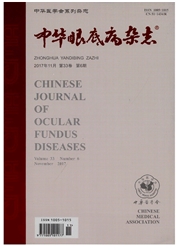

 中文摘要:
中文摘要:
目的观察正常人脉络膜厚度值与性别的关系及其临床意义。方法纳入310例(620只眼)正常志愿者,其中男性152例,女性158例。按照年龄段分组:20—29岁组,30—39岁组,40~49岁组,50~59岁组,60~69岁组,≥70岁组。采用海德堡频域相干光断层扫描仪的加强深度成像扫描模式,测量受检者脉络膜厚度。以通过黄斑中心凹8.8mm扫描线,在0°和90°方位扫描眼底后极部,分别测量中心凹下及距离中心凹1、3mm的上方(S1mm和S3mm)、下方(I1mm和I3mm)、鼻侧(N1mm和N3mm)、颞侧(T1mm和T3mm)共8个方位的脉络膜厚度,观察和分析不同方位的脉络膜厚度与性别之间的关系及其临床意义。性别间各方位和各年龄段的脉络膜厚度比较,均采用两独立样本t检验,方差不齐时采用t′检验。结果310例(620只眼)受检者的黄斑中心凹下脉络膜厚度为(274.81±97.98)μm。其中男性为(294.02±101.47)μm,女性为(256.28±90.87)μm;男性脉络膜厚度较女性明显增加,差异有统计学意义(t′=4.853,P〈0.05)。黄斑区8个方位的脉络膜厚度男性均高于女性(t=5.050,t′=4.597,t′=5.225,t′=5.363,t′=5.608,t=4.239,t′=4.108,t=5.589;P〈0.05)。除≥70岁组外,其他5个年龄段的脉络膜厚度男性均高于女性(t=2.343,t′=2.163,t=3.239,t=2.181,t′=2.982;P〈0.05)。结论各年龄段正常人中,男性脉络膜厚度高于女性。性别是影响脉络膜厚度的因素之一。
 英文摘要:
英文摘要:
Objective To investigate and compare the choroidal thickness between healthy male and female subjects. Method Six-hundred and twenty eyes of 310 healthy volunteers with no ophthalmic disease history were recruited, including 152 males and 158 females. All volunteers were subgrouped into Group A to F according to their ages. Enhanced depth imaging choroidal scans were obtained in all eyes by using spectral-domain optical coherence tomography. Subfoveal ehoroidal thickness (SFCT) and choroidal thickness at 1 mm/3 mm superior, inferior, nasal and temporal to the fovea were measured. Choroidal thickness was compared between male and female in the subgroups with different age. Results Mean SFCT was higher in 152 males ( 298. 02 ± 101.47 ) μm than that in 158 females ( 256. 28± 90. 87 ) μm with statistically significant difference ( t′ =4. 853 ,P 〈0. 05). Choroid at 1 mm and 3 mm from the fovea were also thicker in the male( t′ = 5. 050, t = 4. 597, t = 5. 225, t = 5. 363, t = 5. 608, t′= 4. 239, t = 4. 108, t′ = 5. 589 ;P 〈 0. 05 ). In any subgroup from A to E, SFCT in male was significantly thicker than female, after adjusted for refractive error (t =2. 343 ,t′ =2. 163 ,t =3. 239 ,t =2. 181 ,t′ =2. 982;P 〈0. 05). In Group F, mean SFCT in male was thicker than female, but without statistical significance (t′ = 0. 681, P 〉 0. 05 ). Conclusions Gender was one of the factors that affect the choroid thickness in healthy populations. In subjects under 70, male have thicker choroid than female. This result at least partially explained the gender predilection of macular diseases, such as central serous chorioretinopathy and idiopathic macular hole.
 关于马伟:
关于马伟:
 关于丁小燕:
关于丁小燕:
 关于唐仕波:
关于唐仕波:
 关于李加青:
关于李加青:
 同期刊论文项目
同期刊论文项目
 同项目期刊论文
同项目期刊论文
 期刊信息
期刊信息
